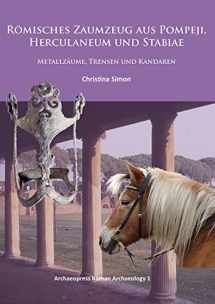
Römisches Zaumzeug aus Pompeji, Herculaneum und Stabiae: Metallzäume, Trensen und Kandaren (Archaeopress Roman Archaeology)
ISBN-13:
9781784910341
ISBN-10:
1784910341
Edition:
UK ed.
Author:
Christina Simon
Publication date:
2014
Publisher:
Archaeopress Archaeology
Format:
Paperback
246 pages
FREE US shipping
Book details
ISBN-13:
9781784910341
ISBN-10:
1784910341
Edition:
UK ed.
Author:
Christina Simon
Publication date:
2014
Publisher:
Archaeopress Archaeology
Format:
Paperback
246 pages
Summary
Römisches Zaumzeug aus Pompeji, Herculaneum und Stabiae: Metallzäume, Trensen und Kandaren (Archaeopress Roman Archaeology) (ISBN-13: 9781784910341 and ISBN-10: 1784910341), written by authors
Christina Simon, was published by Archaeopress Archaeology in 2014.
With an overall rating of 4.0 stars, it's a notable title among other
books. You can easily purchase or rent Römisches Zaumzeug aus Pompeji, Herculaneum und Stabiae: Metallzäume, Trensen und Kandaren (Archaeopress Roman Archaeology) (Paperback) from BooksRun,
along with many other new and used
books
and textbooks.
And, if you're looking to sell your copy, our current buyback offer is $0.3.
Description
Few regions possess so many and mainly complete Roman bridles as do the Vesuvian sites. Singular find conditions permit both comprehensive antiquarian-historian analyses of their production, functionality, and everyday use and new approaches to their typology and chronology. The 103 catalogued specimens belong to four types of bronze headstalls, namely metallic noseband, bitless metal bridle (“hackamore”), multipartite metallic bridle (“metallic halter”), and muzzle as well as two types of bits, namely snaffle bit with circular cheekpieces and curb bit. All of them occurred in more or less numerous variants of local or provincial origin. Special attention is paid to the reconstruction of application methods and combinations of types as well as the replica of a snaffle bit with circular cheekpieces. Bitless metal bridles followed Greek models, multipartite metallic bridles Celtiberian ones and, in combination with Thracian or Italian curb bits, formed typical military bridles. All Campanian finds came from civilian contexts such as luxury villae, villae rusticae, urban houses, and workshops. Thanks to find circumstances they can be attributed to draught animals, beasts of burden or mounts (horse, donkey, mule) which also showed up in stables and skeletal remains.Table of ContentsI. Topographie, Siedlungs- und Forschungsgeschichte der Vesuvstadte: ein uberblick: 1. Kampanien und der Golf von Neapel2. Pompeji3. Herculaneum4. Vor den Stadttoren Pompejis (ager pompeianus)5. Boscoreale6. Stabiae7. Der Vesuvausbruch. II. Antiquarische und kulturhistorische Auswertung des Fundmaterials: A. Metallzaum und Zaumteile aus MetallA. 1. Einteiliger Metallzaum ("Hackamore")A. 2. NasenbandA. 3. MaulkorbA. 4. Mehrteiliger Metallzaum ("Stangenzaum")B. MundstuckeB. 1. Trensen mit ScheibenknebelnB. 2. Kandaren ("Hebelstangentrensen"). III. Zur Verwendung der Zaume bei Reit-, Zug- oder Lastentieren: Einteilige MetallzaumeMetallnasenbanderMehrteilige Metallzaume ("Stangenzaume")Trense mit Scheibenknebel und KinnbugelHebelstangengebisseTrense/Kandare und Langzugel. IV. Pilonius Felix - ein campanischer Bronzeschmied?: Metallzaumform und FundstellenStempelLokalisierung der WerkstattZwei Metallzaume mit dem Stempel eines unbekannten MeistersV. Militarisch oder zivil? Zaumzeug in den VesuvstadtenNachweise militarischer PrasenzDie FundstellenZusammenfassung. VI. Rekonstruktion der Fundorte und Fundstellen. VII. Einsatz und Haltung von Equiden in PompejiMaultiertreiber und MietkutscherHandlerBackerStalleTierarztVIII. Pferd, Esel, Maultier, Maulesel?: Equiden im romischen AlltagEquidenskelettfunde aus den Vesuvstadten: Auswertung. IX. Zusammenfassung: MetallzaumeNasenbanderMaulkorbMehrteilige Metallzaume (Stangenzaume)Trensen mit ScheibenknebelnHebelstangengebisseZu Herkunft und Entwicklung des romischen ZaumzeugsVerwendung der Zaume bei Reit-, Zug- oder LastentierenZur Herstellung der Zaume in Werkstatten von Pompeji (?)Pferdegeschirr aus den Vesuvstadten - militarisch oder zivil?Einsatz und Haltung von Equiden in PompejiBestimmung von Pferd, Esel und Maultier. X. Summary : Bitless bridles made of metalNosebandsMuzzlesMultipartite metallic bridles (metallic halters)Snaffle bits with circular cheekpiecesRoman curb bitsOrigin and development of Roman horse-gearUse of bridles for mounts, draught animals or beasts of burdenProduction of bridles in workshops at PompeiiHorse-gear from the Vesuvian towns - military or civilian?Keeping and use of equids at PompeiiIdentification of horse, donkey, and mule. XI. Fundlisten: A. MetallzaumA. 1. Einteiliger Metallzaum ("Hackamore")A. 2. Metallene NasenbanderA. 3. MaulkorbA. 4. Mehrteiliger Metallzaum (Stangenzaum)B. Trensen und KandarenB. 1. Trensen mit ScheibenknebelnExkurs: Trensen mit KinnbugelnB. 2. Kandaren (Hebelstangengebisse). XII. Konkordanzliste der Fundkurzel und Katalognummern. XIII.Katalog der Metallzaume, Trensen und Kandaren aus den Vesuvstadten: A. MetallzaumA. 1. Einteiliger Metallzaum ("Hackamore")A. 2. Metallene Nasenbander (keine Funde in den Vesuvstadten, ausserhalb siehe Fundlisten)A. 3. MaulkorbA. 4. Mehrteiliger Metallzaum (Stangenzaum) B. Trensen und KandarenB. 1. Trensen mit ScheibenknebelnB. 2. Kandaren (Hebelstangengebisse). XIV. Abbildungsverzeichnis. XV. Verzeichnis der abgekurzten Literatur


We would LOVE it if you could help us and other readers by reviewing the book
Book review

Congratulations! We have received your book review.
{user}
{createdAt}
by {truncated_author}


